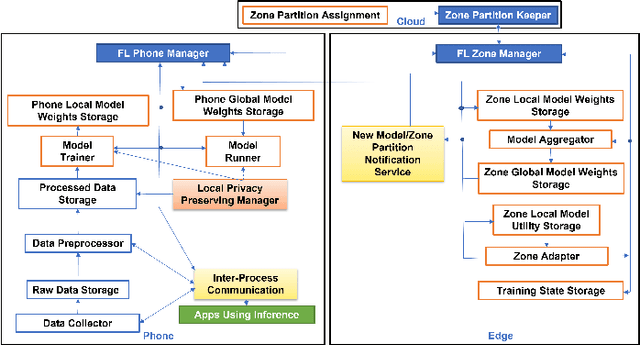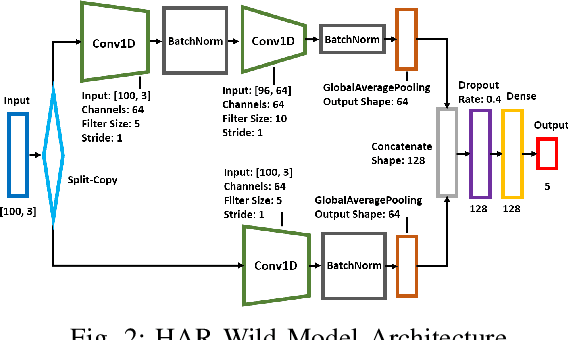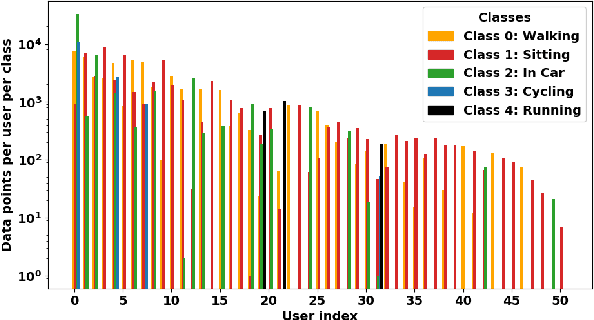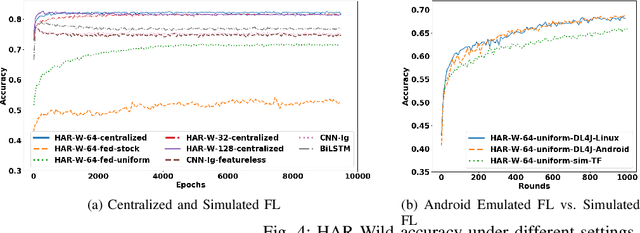Vijaya Datta Mayyuri
FedX: Adaptive Model Decomposition and Quantization for IoT Federated Learning
Apr 19, 2025Abstract:Federated Learning (FL) allows collaborative training among multiple devices without data sharing, thus enabling privacy-sensitive applications on mobile or Internet of Things (IoT) devices, such as mobile health and asset tracking. However, designing an FL system with good model utility that works with low computation/communication overhead on heterogeneous, resource-constrained mobile/IoT devices is challenging. To address this problem, this paper proposes FedX, a novel adaptive model decomposition and quantization FL system for IoT. To balance utility with resource constraints on IoT devices, FedX decomposes a global FL model into different sub-networks with adaptive numbers of quantized bits for different devices. The key idea is that a device with fewer resources receives a smaller sub-network for lower overhead but utilizes a larger number of quantized bits for higher model utility, and vice versa. The quantization operations in FedX are done at the server to reduce the computational load on devices. FedX iteratively minimizes the losses in the devices' local data and in the server's public data using quantized sub-networks under a regularization term, and thus it maximizes the benefits of combining FL with model quantization through knowledge sharing among the server and devices in a cost-effective training process. Extensive experiments show that FedX significantly improves quantization times by up to 8.43X, on-device computation time by 1.5X, and total end-to-end training time by 1.36X, compared with baseline FL systems. We guarantee the global model convergence theoretically and validate local model convergence empirically, highlighting FedX's optimization efficiency.
Zone-based Federated Learning for Mobile Sensing Data
Mar 10, 2023



Abstract:Mobile apps, such as mHealth and wellness applications, can benefit from deep learning (DL) models trained with mobile sensing data collected by smart phones or wearable devices. However, currently there is no mobile sensing DL system that simultaneously achieves good model accuracy while adapting to user mobility behavior, scales well as the number of users increases, and protects user data privacy. We propose Zone-based Federated Learning (ZoneFL) to address these requirements. ZoneFL divides the physical space into geographical zones mapped to a mobile-edge-cloud system architecture for good model accuracy and scalability. Each zone has a federated training model, called a zone model, which adapts well to data and behaviors of users in that zone. Benefiting from the FL design, the user data privacy is protected during the ZoneFL training. We propose two novel zone-based federated training algorithms to optimize zone models to user mobility behavior: Zone Merge and Split (ZMS) and Zone Gradient Diffusion (ZGD). ZMS optimizes zone models by adapting the zone geographical partitions through merging of neighboring zones or splitting of large zones into smaller ones. Different from ZMS, ZGD maintains fixed zones and optimizes a zone model by incorporating the gradients derived from neighboring zones' data. ZGD uses a self-attention mechanism to dynamically control the impact of one zone on its neighbors. Extensive analysis and experimental results demonstrate that ZoneFL significantly outperforms traditional FL in two models for heart rate prediction and human activity recognition. In addition, we developed a ZoneFL system using Android phones and AWS cloud. The system was used in a heart rate prediction field study with 63 users for 4 months, and we demonstrated the feasibility of ZoneFL in real-life.
FLSys: Toward an Open Ecosystem for Federated Learning Mobile Apps
Nov 21, 2021



Abstract:This paper presents the design, implementation, and evaluation of FLSys, a mobile-cloud federated learning (FL) system that supports deep learning models for mobile apps. FLSys is a key component toward creating an open ecosystem of FL models and apps that use these models. FLSys is designed to work with mobile sensing data collected on smart phones, balance model performance with resource consumption on the phones, tolerate phone communication failures, and achieve scalability in the cloud. In FLSys, different DL models with different FL aggregation methods in the cloud can be trained and accessed concurrently by different apps. Furthermore, FLSys provides a common API for third-party app developers to train FL models. FLSys is implemented in Android and AWS cloud. We co-designed FLSys with a human activity recognition (HAR) in the wild FL model. HAR sensing data was collected in two areas from the phones of 100+ college students during a five-month period. We implemented HAR-Wild, a CNN model tailored to mobile devices, with a data augmentation mechanism to mitigate the problem of non-Independent and Identically Distributed (non-IID) data that affects FL model training in the wild. A sentiment analysis (SA) model is used to demonstrate how FLSys effectively supports concurrent models, and it uses a dataset with 46,000+ tweets from 436 users. We conducted extensive experiments on Android phones and emulators showing that FLSys achieves good model utility and practical system performance.
 Add to Chrome
Add to Chrome Add to Firefox
Add to Firefox Add to Edge
Add to Edge